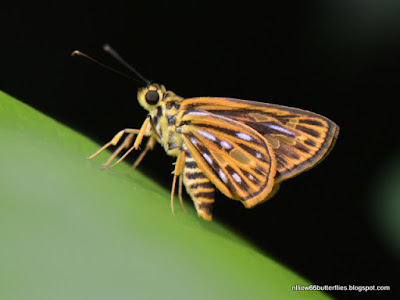This is a rather rare butterfly to be seen in forested areas in Raub, in fact much rarer than A. varuna and they inhabit the same localities. Like most Batwings, they are seasonal and their abundance can fluctuate according to seasons and years.
Habitat indicator
RSP
|
WV
|
PG
|
VF
|
FTR
|
SC
|
LWDF
|
LWPF
|
LMEF
|
UMN
|
MN
|
x
|
x
|
x
|
Frequency observation chart: (S marks the usual
occurences, H marks an unusually high occurence, F for first record)
2014
|
2015
|
||||||||||||
Nov
|
Dec
|
Jan
|
Feb
|
Mac
|
Apr
|
May
|
June
|
Jul
|
Aug
|
Sep
|
Oct
|
Nov
|
Dec
|
S1
|
S1
|
S1
|
S3
|
||||||||||
|
2016
|
|||||||||||
|
Jan
|
Feb
|
Mac
|
Apr
|
May
|
Jun
|
Jul
|
Aug
|
Sep
|
Oct
|
Nov
|
Dec
|
|
|
|
|
|
|
|
|
|
|
|
|
|
The 5th instar caterpillar looks much like a Troides caterpillar. I came upon this one by accident when I was looking for hesperiids along a trail used by Orang Asli to look for bamboo. 02 Feb 2015 @ 11:17. When threatened, the caterpillar everts a bright orange osmeterium.
Above 2 pictures of the pupa a week later in the same spot of the undergrowth...8 Feb 2015. Collected the pupa out of curiosity (it doesn't correspond to that of Troides nor Pachliopta with its beautiful coral-like projections) and 2 weeks later, this came out (below picture)...The pupa case darkens from coral colour to dark brown 2 days prior to eclosion.
A rather tiny male eclosed at @ 15:00 on 23 Feb 2015, 15 days after the pupa was collected from a dark undergrowth of a forest reserve. Unlike A. varuna, its abdomen is completely black. The carmine tufts are restricted to the thorax.
The uppersides are of a velvety black ...
Notice the scent pouch on the HW dorsal area.
The HW uppers has a rather shiny velvety dull blue sheen much like A. varuna male.












































